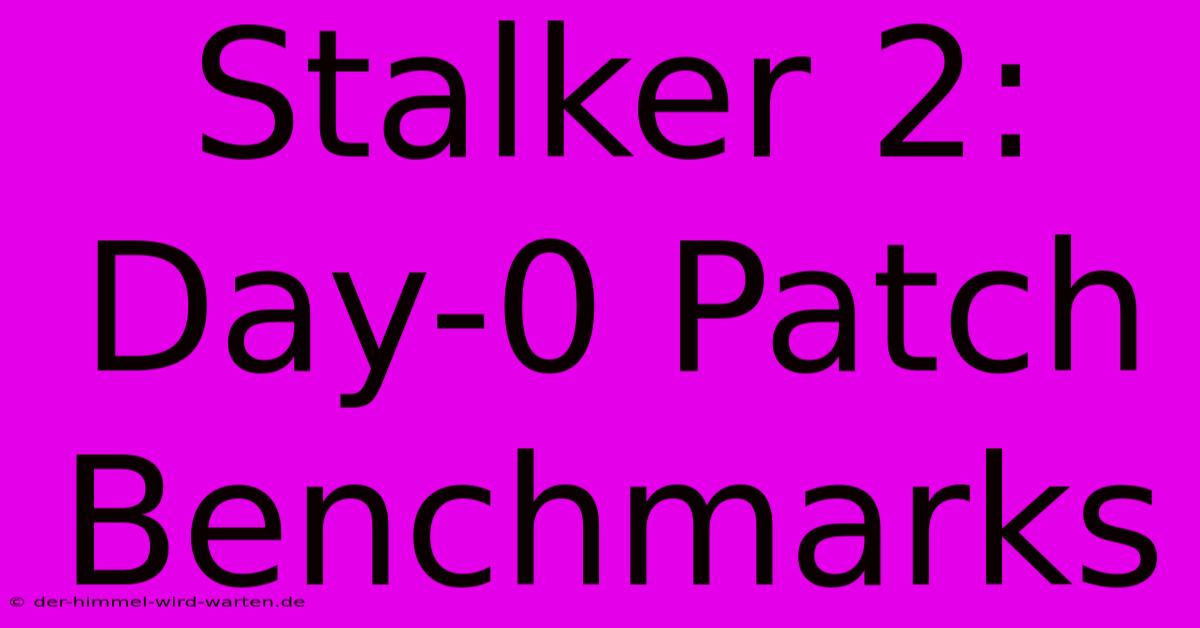Stalker 2: Day-0 Patch Benchmarks

Discover more detailed and exciting information on our website. Click the link below to start your adventure: Visit Best Website Stalker 2: Day-0 Patch Benchmarks. Don't miss out!
Table of Contents
Stalker 2: Day-0 Patch Benchmarks: My Rig's a Beast...or is it?
Okay, so Stalker 2 finally dropped, right? Huge hype, massive expectations, and my PC? Well, let's just say I was slightly worried. I'd upgraded my rig a few months back, but you never really know until you throw a game like Stalker 2 at it. This ain't your grandma's slideshow; this is next-gen graphics, folks. I'm talking ray tracing, insane detail...the whole shebang.
I knew I had to test the Day-0 patch, mainly because of all the pre-release chatter. You know, the stuff about optimization and all that tech jargon. So, I dove right in, ready to benchmark the heck out of this thing.
My Setup: The Specs
Before I bore you with my findings, here’s what I was working with:
- CPU: AMD Ryzen 7 7700X – Pretty beefy, right?
- GPU: RTX 4070 – Hoping this would handle the ray tracing without too much complaining.
- RAM: 32GB DDR5 – Plenty of headroom, I thought.
- Storage: NVMe SSD – Fast loading times are a must for a game this intense.
I used a mix of pre-set settings and custom tweaks. I wasn’t aiming for max settings because even my rig would probably melt. My goal? Find a sweet spot between performance and visual fidelity.
The Day-0 Patch: First Impressions
The Day-0 patch itself was a bit of a rollercoaster. The initial download was smoother than expected (no crazy errors!), but the in-game experience was… varied. Some areas ran flawlessly, silky smooth at 60fps on high settings. Other areas? Let's just say my frame rate took a nosedive faster than a lead balloon. I mean, seriously, some areas were barely playable.
I think the optimization was a little rough around the edges. Some textures popped in later than others. This wasn't a major deal breaker; these things can happen, especially with massive open-world games like Stalker 2.
Benchmark Results: The Good, the Bad, and the Ugly
I ran a series of benchmarks in different areas; open fields, dense forests, and some of those intense indoor environments. The results varied wildly, depending on the scene.
- Open areas: Generally smooth, even with ray tracing enabled. Around 50-60fps. Good stuff!
- Dense environments: This is where things got dicey. Frame rates dipped to the low 30s, sometimes lower. I had to turn down some settings to get back into that playable range. Ouch.
- Indoor areas: Performance varied a lot. Some indoor areas ran better than others. This makes me suspect some inconsistencies.
I also noticed some micro-stuttering. This annoying little issue caused slight pauses, especially noticeable during fast movement. Again, this might be related to optimization, but I'm not a tech wizard.
Tips and Tricks: Getting the Most Out of Stalker 2
Here's what I learned:
- DLSS is your friend: If you've got a compatible card, enabling DLSS significantly boosted my performance without killing the visuals.
- Tweak your settings: Don't be afraid to experiment! I found that turning down shadows and some less noticeable effects made a big difference without a major impact on visuals.
- Check your drivers: Make sure your graphics drivers are up-to-date. It sounds obvious, but it's vital for optimal performance.
Conclusion: A Work in Progress
Stalker 2 is gorgeous, no doubt. But the Day-0 patch isn't perfect. While my high-end PC mostly handled the game, there are still optimization issues that need addressing. I'm hoping future patches will iron out these wrinkles. I’m excited to see how it progresses. Until then, I'll be tweaking my settings and exploring the Zone! It’s not all bad, though – I am really enjoying this game!

Thank you for visiting our website wich cover about Stalker 2: Day-0 Patch Benchmarks. We hope the information provided has been useful to you. Feel free to contact us if you have any questions or need further assistance. See you next time and dont miss to bookmark.
Featured Posts
-
Nestle Senkt Kosten 2 5 Milliarden Ziel Bis 2027
Nov 20, 2024
-
Sensationell San Marino Gewinnt 3 1
Nov 20, 2024
-
Stalker 2 Im Test Action Highlight
Nov 20, 2024
-
Boris Pistorius Portraet And Karriere
Nov 20, 2024
-
Tuchel Vs Zaragoza Die Retourkutsche Kommt
Nov 20, 2024
